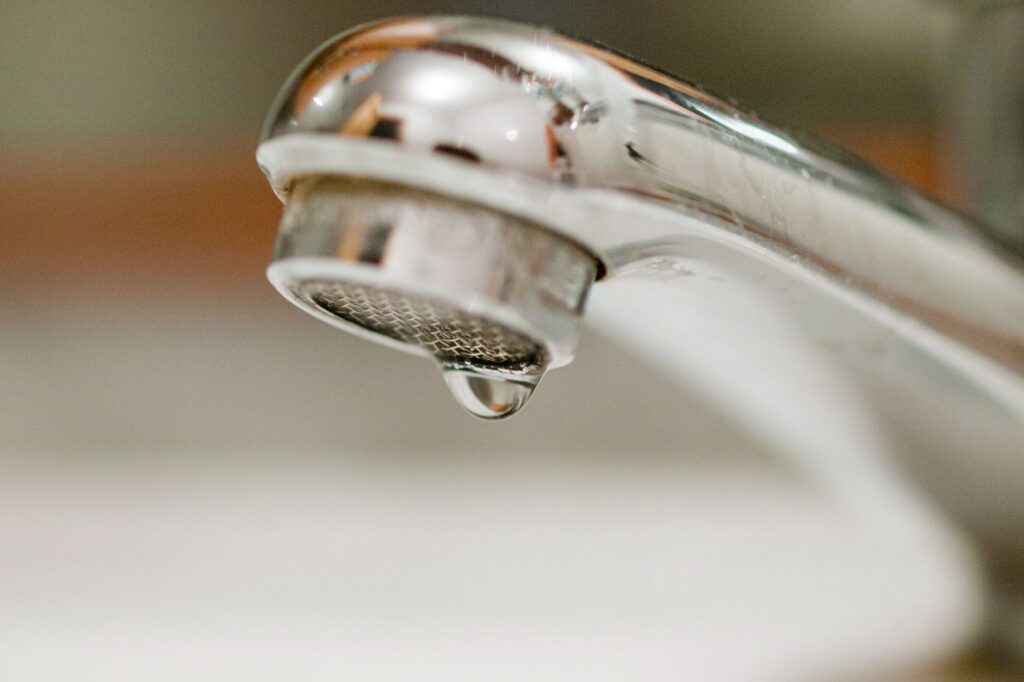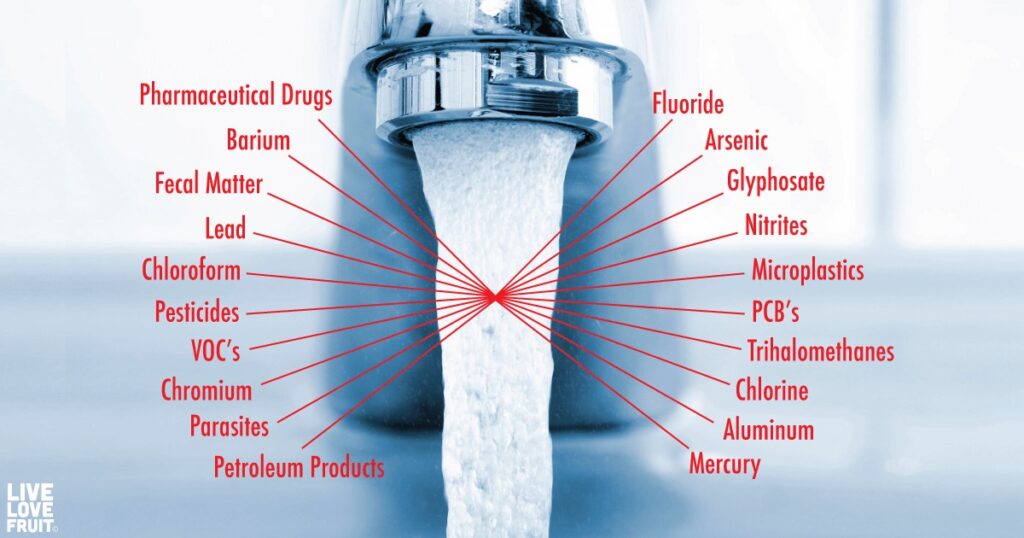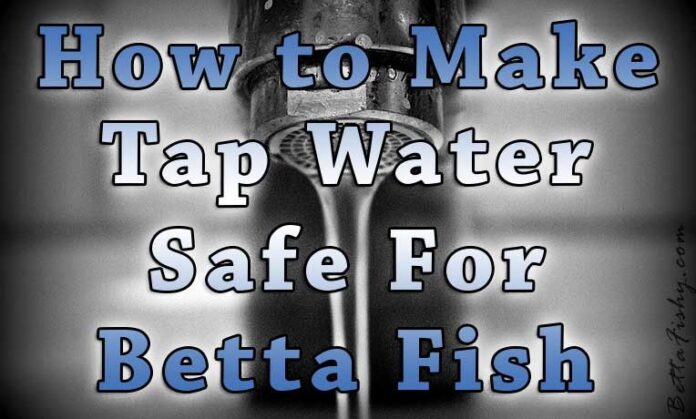The rest of this article is going to contain information about commonly found “contaminants” inside of your typical every day straight tap water source. Were not gonna cover all of the more exotic contaminants, but do our best to address the most commonly found chemicals and toxins that could potentially harm your fish.
Chlorine And Chloramines In Tap Water
Starting off the list is the most commonly found chemical substance that exists pretty much in every municipal water supply. That would be your tap water. The addition of chlorine and chloramine to city tap water is purposeful because these chemicals act as an oxidizer to the water. Oxidizing chemicals are substances that gain electrons by way of chemical reaction. Chlorine and chloramines can harm and actually easily kill fish by poisoning their blood and greatly damaging their gills.
The chlorine found in tap water is, luckily, incredibly easy to remove with the addition of an aquarium water conditioner.
The chlorine found in tap water is, luckily, incredibly easy to remove with the addition of an aquarium water conditioner. Beta aquarium water conditioners contain de-chlorinators that break apart and neutralize the chlorine content in the tap water thereby rendering the chemical inert. Chlorine actually tends to remove itself from a water source by natural oxidation. The longer you let a bowl full of water with chlorine in it set out in the open, the more the chlorine will dissipate. Natural oxidation by way of letting a container full of water sit for a while coupled with a water conditioner is a sure way to make sure that your “soon to be” betta fish aquarium water is rid of chlorine. If you wanted to go the route of naturally removing the chlorine content from your tap water without the use of a water conditioner for aquariums (not necessarily recommended), you should let the tap water sit in an open topped container with an air stone pumping bubbles up from the bottom (you are looking for constant water agitation) for at least 24 hours. The larger the surface of the water is that actually touches the air, the more thoroughly the chlorine content will dissipate. It’s all about oxidation.
Now, the oxidation and agitation method outlined above will remove chlorine from your tap water, but not chloramine. Both chlorine and chloramine are commonly found in municipal water supplies. Chlorine and chloramine are two different types of chemicals. I don’t think I needed to state that, I just wanted to be clear. There are some cities and towns that employ the use of chloramines as they are more stable chemical than their chlorine counterpart. In fact there are some cities that are switching to chloramine only treatments. My personal city has been debating this route for only the last few months. Chloramines are just bad for bettas, in my personal opinion I don’t think they’re that hot for people either.
Generally the use of chloramines instead of chlorine occurs when water has to be trucked in over long distances. If you live in a drought stricken area and your city or town house to bring water in from an outside source, there’s a good chance that that water has been treated with chloramine.
Chloramines are kind of like a mix of chlorine in ammonia. This is a substance that you cannot boil out. You can let it sit in open topped container for a very long time with or without an agitating bubble stone and the chloramine content won’t be affected.
Chloramine just so happens to be almost instantly removed from tap water with the addition of a de-chlorinating agent such as your typical aquarium water conditioner.
When chloramine happens to pass through the fishes gills and therefore enters the bloodstream of the fish, it starts to react with the hemoglobin forming itself into Methemoglobin. After this formation, the the fish will suffer low oxygen in their bodily tissues because their hemoglobin’s are being replaced. Hemoglobin’s are responsible for oxygenating the blood. To put it another way, you can think of this as a kind of suffocation. Fish that are exposed to high levels of chloramine typically exhibit severe and immediate reactions to the substance. Rapid gasping and darting around the tank are generally the first symptoms but quickly followed by close to immediate death.
Mind you the example outlined above was pertaining to particularly high levels of chloramine. The levels of chloramine in your tap water will most likely not be high enough for a fish to show immediate symptoms of distress. Home aquarium fish can exhibit these symptoms, however, if they are left in a prolonged exposure to the chemical chloramine found in typical tap water supply.
Okay, time for some good news. Chloramine just so happens to be almost instantly removed from tap water with the addition of a de-chlorinating agent such as your typical aquarium water conditioner. These water conditioners are made and manufactured by many different companies. Some of the more popular choices include the product SeaChem prime and those made by tetra. Just in case you’re curious, my personal favorite is and will always be SeaChem prime as I have never once had an issue with it.
Other Ways Of Removing Chloramine

There are very few other ways of removing chloramine from your tap water. The only in my opinion worth mentioning though is reverse osmosis. In a typical reverse osmosis system (also known as RO system) there is a carbon filter that is used as a pre-filtration to the rest of the RO procedure. The RO system will more or less turn the chloramine into ammonia, removing chloramine from the equation while leaving behind a bit of ammonia. One thing you should know is that ammonia is only partially taken out of the water through reverse osmosis. The extent of the ammonia’s removal by the RO system really depends on the initial pH level of the water.
In general I would not recommend using 100% reverse osmosis system water in your bettas aquarium. The reason for that is that every single trace of important mineral to the fish has been stripped completely from the water. Your fish need certain minerals in their water to help maintain their osmoregulation. Is also exactly why you should not use distilled water in your freshwater aquarium. Water distillation removes all minerals as well.
Inorganic Chemicals In Tap Water:
Nitrates, Nitrites, Copper, Fluoride and Phosphates
Most of these in organic materials should look familiar to you if you have been raising betta fish for any given amount of time. These are all types of inorganic chemicals that are commonly found in tap water. Typical tap water sources contain up to one ppm. You will most likely find nitrate levels up to 10 ppm. The typically low levels of both nitrites and nitrates pre-existing in tap water can be easily removed with a water conditioner such as the aforementioned SeaChem prime. Having a good bio filter in place will greatly aid the removal of these contaminants as well. Interesting thing about nitrates in the tap water is that, depending on which study you look at, levels above 10 to 30 ppm will cause infants under six months of age (human infants) to become ill and exhibit symptoms like blue baby syndrome. If that’s something that piques your curiosity, do a Google search for “nitrates blue baby syndrome” and see what you find. The very first result (as of right this moment for me anyway) is from the WHO and talks all about it. Scary stuff. While that has nothing to do it betta fish, or aquarium keeping in general, you may have a family and this might be something that interests you. Moving on…
The typically low levels of both nitrites and nitrates pre-existing in tap water can be easily removed with a water conditioner such as the aforementioned SeaChem prime
These levels of nitrates and nitrites (10 ppm and 1 ppm respectively) that are commonly found straight from the tap water will generally not cause your fish any harm. These are fairly regular, and fairly low, levels for any betta fish aquarium. I just wanted to inform you about common occurrence of nitrites and the nitrates pre-existing in tap water. Especially because those are two inorganic chemicals that betta enthusiasts spend much of their time fighting.
There are certain other “allowed chemicals” that are worth mentioning. Copper is commonly found at around 1.3 ppm. Fluoride can be found at around 4 ppm. Phosphates are also common in tap water. As for the copper, these are fairly low levels and will not pose a problem for you in your aquarium. It’s good to take note of that though because there are times when you treat your aquarium with a product containing copper in it such as copper sulfate. If the particular medicine that you are using to treat a condition in your aquarium calls for exact measurements of copper, now you know the baseline of the pre-existing copper content that could possibly be found in your aquarium.
One other side note about copper content in tap water is that if your home has copper plumbing, you will have naturally occurring copper in the water straight from your tap. Copper levels at or above 25 ppm can cause harm to most species of fish in general. Those levels are kind of hard to reach on their own mind you. You would really almost have to try hard to get your copper levels that high.
Many cities and towns add phosphates to their water supply because they have been shown to reduce lead commonly found in drinking water.
Many cities and towns add phosphates to their water supply because they have been shown to reduce lead commonly found in drinking water. The problem with phosphates in aquarium water is that they tend to exacerbate algae growth. This is more so the case with blue-green algae. But hey, at least you don’t have to worry about high levels of lead!
Fluoride is last on this list mostly because I’m coming up nil with conclusive studies on the effects of fluoride on any common home aquarium fish. Now, the Internet is full of articles on harmful effects of fluoride in humans and also equally full of articles stating how it’s completely healthy. My article just has to do with betta fish in home aquariums swimming in water straight from the tap. I’m going to have to let you draw your own conclusions on the danger of fluoride in tap water as it relates to your aquarium.
TDS (Total Dissolved Solids) In Tap Water

Salts, metals and minerals that are dissolved in water make up the TDS, or total dissolved solids category. Actually, anything in water other than pure H2O could fall in this category including suspended solids. Substances that are neither dissolved or settled in the water are considered suspended solids. Total dissolved solids are generally measured in parts per million, which is the way to weight ratio of an ion to water.
Reverse osmosis systems can drastically lower the total dissolved solids from tap water sources. Remember that reverse osmosis is also capable of removing even trace amounts of minerals from the water, therefore total dissolved solids are easy prey.
Inorganic Chemicals In Tap Water:

The EPA (Environmental Protection Agency) states that 20 mg or less of sodium per liter is the perfect amount to have in everyday drinking water. Generally speaking, having a level higher than this suggestion will end up chasing out certain specific minerals that fish find essential for their general well-being. Calcium and magnesium are two of the more important minerals that high levels of sodium will chase away. Levels over 270 mg/L in freshwater would generally be regarded is very high. Maintain the correct amount of minerals at this level of sodium would be beyond difficult in maintaining a healthy aquarium. If you haven’t put together yet, this is all being stated as proof of why you should not ever use water that’s been passed through a water softener (that uses salt to soften the water) for use in any type of aquarium.
Wrap-Up
It should be noted that most bottled water should not be used to fill up your bettas aquarium 100%. Now I said most, not all. Ones that you should certainly watch out for and avoid would be distilled water and what’s known as “drinking water”. Drinking water is more often than not water that’s been passed through a reverse osmosis system having the minerals stripped from it and then adding choice minerals back into it just to accommodate the pallet. Distilled water of course doesn’t have any minerals in it at all. If you can find a bottle of water that is labeled “spring water”, and you know for a fact it actually came and was sourced from a spring, that kind of water is generally okay for use in an aquarium.
using a water conditioner such as SeaChem prime will help neutralize any of the toxic materials in your tap water and make your tap water safe for your betta fish to swim in.
After all is said and done, I hope you understand that using straight tap water to fill up your betta fish aquarium is not the wisest idea in the world. I hope this article didn’t scare you too much and that you don’t run out of the room every time somebody goes to wash their hands. Tap water has some pretty harmful things in it that can really end up hurting your betta fish. As I mentioned a few times before, using a quality water conditioner such as SeaChem prime will help neutralize any of the toxic materials in your tap water and make your tap water safe for your betta fish to swim in. Regardless of what water conditioner you choose to purchase, the one thing all water conditioners have in common is that they all have easy-to-follow and detailed directions on how to use them. Please read them. I’ve never seen a water conditioner that was not easy to read and easy-to-follow. Thank you for taking the time to read this lengthy article and if you feel like being a good Samaritan to somebody else’s fishy, take the time to find a “share” button on this page and give it a quick press!


